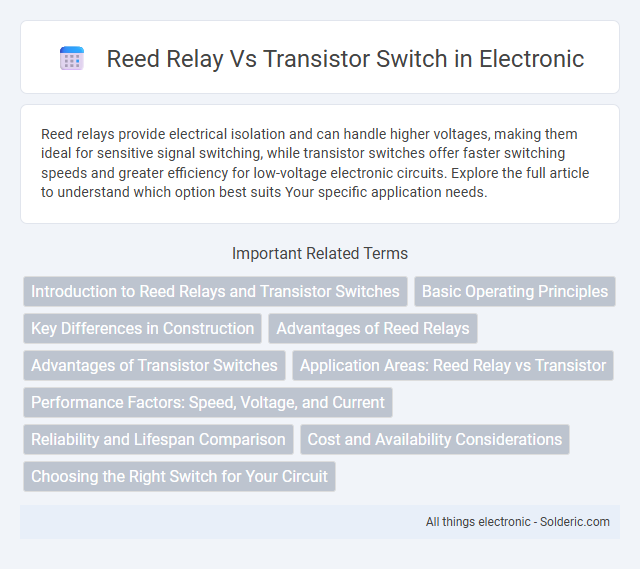Reed relays provide electrical isolation and can handle higher voltages, making them ideal for sensitive signal switching, while transistor switches offer faster switching speeds and greater efficiency for low-voltage electronic circuits. Explore the full article to understand which option best suits Your specific application needs.
Comparison Table
| Feature | Reed Relay | Transistor Switch |
|---|---|---|
| Switch Type | Electromechanical | Semiconductor |
| Switching Speed | Slower (milliseconds) | Faster (nanoseconds to microseconds) |
| Power Consumption | Higher (coil current required) | Lower (minimal base current) |
| Contact Life | Limited, subject to mechanical wear | Very long, solid-state with no mechanical wear |
| Voltage/Current Handling | Higher voltage isolation, moderate current | Limited voltage isolation, can handle high current with proper design |
| Signal Integrity | Mechanical contacts may introduce bounce | No contact bounce, cleaner switching |
| Size | Bulkier due to coil and contacts | Compact, integrates easily on PCB |
| Cost | Higher cost per unit | Generally lower cost |
| Typical Use Cases | High voltage isolation, switching RF signals | Digital switching, fast on/off control |
Introduction to Reed Relays and Transistor Switches
Reed relays consist of thin metal reeds enclosed in a glass tube that close or open contacts when an electromagnetic coil energizes, providing fast, reliable switching with low contact resistance and high isolation. Transistor switches utilize semiconductor devices such as bipolar junction transistors (BJTs) or MOSFETs to control current flow electronically, offering high-speed switching and low power consumption without mechanical wear. Your choice between reed relays and transistor switches depends on application requirements like contact isolation, switching speed, and longevity.
Basic Operating Principles
Reed relays operate through an electromagnetic coil that generates a magnetic field, causing ferromagnetic reeds inside the switch to close and complete the circuit. Transistor switches use semiconductor materials to control current flow by applying a voltage to the base or gate terminal, enabling amplification or switching of electronic signals. The fundamental difference lies in the mechanical movement in reed relays versus the solid-state, electron flow control in transistor switches.
Key Differences in Construction
Reed relays feature sealed glass capsules containing ferromagnetic reeds that close contacts via magnetic fields, ensuring low contact resistance and electrical isolation. Transistor switches rely on semiconductor materials with layers of doped silicon that modulate current flow through charge carrier injection, enabling fast switching speeds without mechanical parts. The distinct physical construction leads to reed relays exhibiting mechanical actuation with durability in isolated circuits, while transistor switches provide solid-state reliability and miniaturization advantages.
Advantages of Reed Relays
Reed relays offer superior isolation and low contact resistance compared to transistor switches, making them ideal for sensitive signal switching applications. Their hermetically sealed contacts provide high reliability and long life with minimal contact wear, ensuring consistent performance over millions of operations. You benefit from noise-free switching and fast response times, crucial for precision measurements and telecommunications.
Advantages of Transistor Switches
Transistor switches offer faster switching speeds and greater reliability due to their solid-state construction, eliminating mechanical wear and tear found in reed relays. They consume less power, enabling energy-efficient circuit designs, and provide precise control with minimal electrical noise, making them ideal for high-frequency applications. Transistors also support integration into compact semiconductor devices, facilitating advanced miniaturization in modern electronics.
Application Areas: Reed Relay vs Transistor
Reed relays are widely used in sensitive measurement instruments and telecommunications for their excellent isolation, low contact resistance, and ability to switch high voltages or currents with minimal signal distortion. Transistor switches are preferred in digital circuits, power regulation, and fast switching applications due to their compact size, low power consumption, and high-speed switching capabilities. Reed relays excel in environments requiring galvanic isolation, while transistor switches dominate in integrated circuits and microcontroller interfacing.
Performance Factors: Speed, Voltage, and Current
Reed relays offer fast switching speeds typically in the range of a few milliseconds and excel at handling high voltages up to several hundred volts, making them suitable for sensitive signal isolation applications. Transistor switches provide much faster switching times in the nanosecond to microsecond range and efficiently handle a wide range of currents, albeit often at lower voltage levels than reed relays. Your choice depends on whether you prioritize higher voltage isolation with moderate speed (reed relay) or ultra-fast switching with efficient current handling (transistor switch).
Reliability and Lifespan Comparison
Reed relays offer superior reliability in high-voltage switching applications due to their hermetically sealed contacts, which prevent oxidation and ensure consistent performance over millions of cycles. Transistor switches, while faster and more suitable for low-voltage and high-frequency operations, have limited lifespan influenced by thermal stress and semiconductor degradation. Your choice between reed relay and transistor switch should consider the trade-off between mechanical durability of reed relays and the electronic switching longevity of transistors under specific usage conditions.
Cost and Availability Considerations
Reed relays typically have higher costs due to their mechanical components and specialized manufacturing, which can limit availability compared to transistor switches that are mass-produced and widely accessible. Transistor switches offer cost-effective solutions with consistent performance, making them ideal for budget-sensitive projects requiring high volume. When selecting components for Your application, consider reed relays for isolated switching despite higher costs and transistor switches for general-purpose needs with better availability.
Choosing the Right Switch for Your Circuit
Choosing the right switch for your circuit depends on factors like switching speed, signal integrity, and power handling. Reed relays offer excellent isolation and low contact resistance, making them ideal for sensitive analog signals and high-frequency applications. Transistor switches provide faster switching speeds and are more suitable for digital circuits requiring high switching frequencies and low power consumption.
Reed relay vs Transistor switch Infographic

 solderic.com
solderic.com